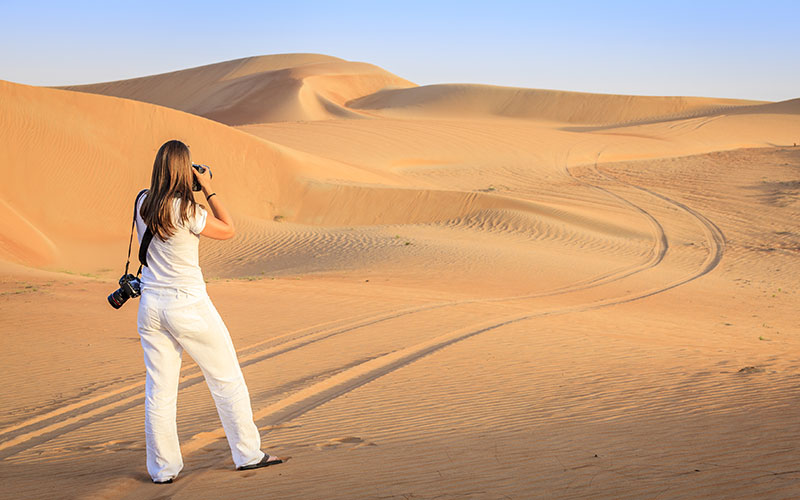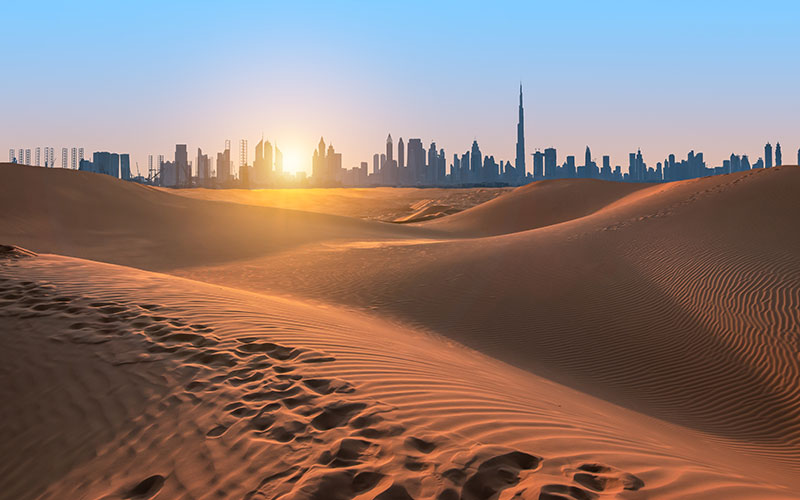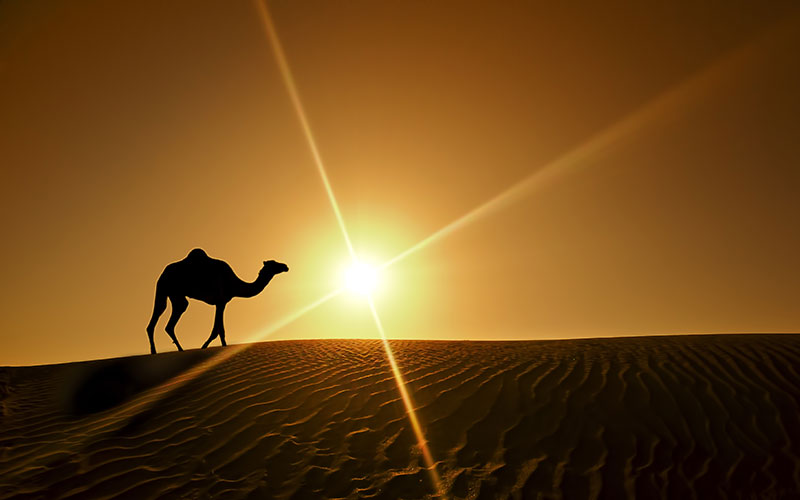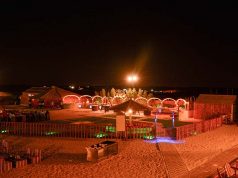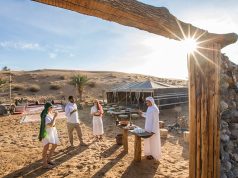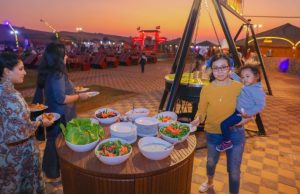The Dubai desert is known for its breathtaking beauty and unique landscapes, making it a photographer’s paradise. But capturing the essence of this stunning terrain can be challenging without the right equipment and techniques.
Whether you’re an amateur or professional photographer, our photography tips and tricks will help you take beautiful photos of the Dubai desert landscape. From essential equipment to post-processing techniques, we’ll guide you through every step of the way so that you can showcase your skills and capture the magic of this awe-inspiring destination!
So grab your camera gear, and let’s get started on this photographic adventure.
Essential Equipment You Will Need To Take Beautiful Photos of the Dubai Desert
To capture the beauty of the Dubai desert landscape, you will need to come prepared with essential equipment.
1. Camera
The first and most obvious item is a camera. Whether it’s a DSLR or mirrorless camera, having a good quality camera is important for taking clear and sharp photos.
2. Tripod
The next important piece of equipment is a sturdy tripod. This will help keep your shots steady and avoid any unwanted blur caused by shaky hands or uneven surfaces.
3. Lenses
A wide-angle lens is recommended for capturing the vast landscapes of the desert. Consider bringing a telephoto lens as well for capturing detailed shots of distant subjects.
4. A Polarizing Filter
When taking photos in bright sunlight, a polarizing filter can be beneficial in reducing glare and improving color saturation. It helps to produce images with more vivid and vibrant colors.
5. Extra Accessories
If you plan on doing some night photography, then bringing along extra batteries, memory cards, and even an external flash can be helpful.
6. Dust Blower
The desert environment can be dusty, so bring a dust blower to remove dust and sand from your camera and lenses.
How to Compose Your Shots
Composing a great shot is not just about pointing your camera at the subject and pressing the shutter button. There are several factors to consider when composing your shots, especially in the desert landscape.
Here are some tips on how to compose your shots:
1. Use the rule of thirds: By dividing your frame into nine equal parts using two vertical and two horizontal lines, you can strategically position important elements of your composition at the intersections or along these lines. This will create balance and add interest to your photo.
2. Pay attention to foreground, middle ground, and background: Adding layers to your composition can make it more interesting. Try to focus on objects at different depths in relation to each other for depth perception.
3. Use leading lines: Leading lines allow you to draw attention toward specific points of interest within the image by guiding viewers’ eyes through it.
4. Experiment with angles: Try shooting from different angles – high above or down low – for a unique perspective that makes an ordinary scene look extraordinary.
You can always use a drone camera for bird eye view shots. Before that, get permission from the tour company.
5. Simplify: Don’t try to include too much in one shot, as it will distract viewers from what’s really important in the photo.
By following these guidelines, you’ll be able to capture stunning photos that showcase the beauty of Dubai’s desert landscape!
Lighting Effects For Better Photographs
A crucial factor in capturing beautiful photographs of desert landscapes is lighting. The harsh sunlight and shadows of the desert can either make or break your shot. Therefore, it’s essential to understand how to use lighting effectively.
- Backlighting: A technique for utilizing natural light in your favor while photographing deserts is backlighting. Shooting with a subject backlit can create some compelling silhouettes that add depth and drama to your images.
- Use Artificial Lights: You can also experiment with artificial lights such as flashlights or portable LED panels while shooting at night-time in deserts. These tools allow you to control where and how much light you want on specific parts of your image.
Post-Processing Techniques for Enhancing Your Photos
Post-processing is an essential part of enhancing your photos after you have captured them. With the right techniques, you can transform a simple desert landscape into a stunning masterpiece.
Here are some post-processing tips to help enhance the beauty of your Dubai desert photos.
1. Shoot In Raw Format
Shooting in the RAW format gives you more flexibility when editing later on.
2. Adjust Contrast And Shadows
Start by adjusting the exposure and white balance to make sure that your photo looks well-balanced before moving on to other adjustments.
Next, adjust the contrast and shadows in your photo to add depth and dimensionality. Play around with saturation levels while keeping it natural-looking so that colors pop but still look realistic.
3. Use HDR
You may also want to consider using HDR (High Dynamic Range) technique for better detail capture in high-contrast scenes like a sunset or sunrise over sand dunes.
4. Sharpening
Sharpening is important, but avoid overdoing it as this may introduce noise or grains into your image leading to unnatural texture.
Remember that post-processing should not be used as a crutch for poor photography skills but rather used to enhance shots taken with good techniques.
Best Time of Day to Take Pictures in The Dubai Desert
The Dubai Desert is one of the most awe-inspiring landscapes in the world and also one of the best Instagrammable places in Dubai. It offers a unique opportunity for photographers to capture some truly stunning images.
However, capturing these images can be challenging if you don’t know when it is the best time of day to take pictures.
1.During Sunrise or Sunset
One of the best times to take photographs in the desert is during sunrise or sunset. The light during these times creates long shadows and provides a warm glow that adds depth and texture to your photos.
This also helps create more vibrant colors that make your photos pop.
2.Avoid Midday Sun Unless Absolutely Necessary
Midday sun can be harsh and lead to overexposed photos with blown highlights. So it’s important to avoid shooting at this time unless you’re looking for specific lighting effects like silhouettes or high-contrast shots.
3.Golden Hour
Golden hour (around an hour before sunset) provides soft, diffused light, perfect for portrait-style shots where you want flattering skin tones without harsh shadows or bright highlights distracting from your subject.
4.Blue Hour
Blue hour (just after sunset) gives off a blue hue which contrasts well against warm sand dunes creating striking visual compositions with contrasting colors.
Common Mistakes to Avoid When Photographing the Dubai Desert
When it comes to photographing the desert landscape in Dubai, there are some common mistakes that amateur photographers make.
1. Not doing enough research on the location and its unique features.
Many people assume that all deserts look the same, but each one has its own distinct characteristics.
2. Not bringing along the necessary equipment for shooting in such a harsh environment.
The hot and dry conditions can be tough on both you and your camera gear, so be sure to bring extra batteries, plenty of water, and protective cases for your equipment.
3. Composition is also key when taking pictures of the desert landscape.
Some photographers make the mistake of centering their subjects or neglecting to include foreground elements that can add depth to their shots. Be mindful of leading lines, the rule of thirds, and other composition techniques to create visually striking images.
4. Many beginners forget about lighting when capturing photos in this environment.
Shooting during the midday can result in washed-out images with harsh shadows due to strong overhead sunlight.
It’s best to shoot during sunrise or sunset hours when the light is softer and more flattering.
5. Don’t rely too heavily on post-processing software like Photoshop or Lightroom.
While these tools can enhance an image’s colors or contrast, they cannot save a poorly composed shot or fix blurry focus caused by shaky hands or poor technique.
6. Use a narrow aperture
When capturing desert landscapes, it’s important to follow the same rules as with general landscapes. To get a clear and focused photo, use a narrow aperture and work with a low ISO.
It’s suggested that you set your aperture between f/8 – f/11 for optimal results. This range will help maintain a reasonable depth of field.
7. Be mindful of privacy laws
Privacy is a huge matter in the UAE, and taking pictures of people without permission is illegal.
Article 378 of the UAE Penal Code states that clicking a person’s photo in Dubai without their consent is considered an invasion of privacy, and you may be punished.
Tips and Tricks for Capturing the Beauty of the Desert Landscape
Capturing the beauty of the desert landscape can be challenging but rewarding. Here are some tips and tricks to help you make the most of your desert photography:
- Use natural light: The desert offers beautiful natural light, especially during sunrise and sunset. Try shooting during these times for optimal lighting conditions.
- Look for patterns and textures: The desert landscape offers unique patterns and textures. Look for interesting shapes and lines in the sand and rocks to add depth to your photos.
- Incorporate elements of contrast: Desert landscapes often offer a high level of contrast between light and dark areas. Use this to your advantage by incorporating contrast into your compositions.
- Capture motion: The desert can be windy, so use this to your advantage by capturing the motion of the sand or plants. Use a slower shutter speed to create a sense of movement.
- Be mindful of the environment: The desert is a fragile ecosystem, so be mindful of your impact on the environment. Avoid trampling on plants or disturbing wildlife.
Conclusion
Capturing the beauty of the desert landscape can be challenging, but with the right equipment and techniques, you can take stunning photographs that capture its essence. By following these photography tips and tricks, you will be able to create images that are both beautiful and memorable. Remember to bring essential equipment such as a tripod, polarizing filter, wide-angle lens, and extra batteries. Take your time when composing your shots, pay attention to lighting effects, and experiment with post-processing techniques to enhance your photos. Use these tips as a starting point for exploring new ways to capture the beauty of this unique landscape through photography!

